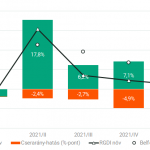
Fertő Imre tudományos tanácsadó és Stefan Bojnec közös cikke Drivers of the duration of comparative advantage in the European Union’s agri-food exports címmel megjelent az Agricultural Economics – Zemeldska Ekonomika folyóiratban.
The article investigates the duration of comparative advantage indices in the European Union (EU-27) agri-food exports using the normalised revealed comparative advantage index on the global market. There is employed both a descriptive analysis of the duration of comparative advantage, and examined the major drivers using discrete-time duration models with proper controls for unobserved heterogeneity. The robustness of the models is tested with alternative estimation
procedures and sub-samples. Estimations show that the comparative advantages for most agri-food products survived for a certain number of years, but a high percentage of them have a shorter duration. Larger trade costs decrease the probability of survival in comparative advantages, while the level of economic development, the size of the country, the agri-food export diversification, and being a new EU member state increases it. Implications for the EU-27 member states and agri-
-food policies are suggested in the conclusion.
Nem található esemény a közeljövőben.
A KRTK Közgazdaság-tudományi Intézet teljesítményéről A KRTK KTI a RePEc/IDEAS rangsorában, amely a világ közgazdaság-tudományi tanszékeit és intézeteit rangsorolja publikációs teljesítményük alapján, a legjobb ... Read More »

Tisztelt Kollégák! Tudományos kutatóként, intézeti vezetőként egész életünkben a kutatói szabadság és felelősség elve vezetett bennünket. Meggyőződésünk, hogy a tudomány csak akkor érhet el ... Read More »

Srí Lanka: a 2022-es gazdasági válság leckéje – A. Krueger Lessons from Sri Lanka Anne O. Krueger Jul 25, 2022 – Project Syndicate ... Read More »

A permanens válság korában élünk – J. Meadway We’re living in an age of permanent crisis – let’s stop planning for a ‘return ... Read More »

A 2021 végén, illetve 2022 elején tapaszalt 6, illetve 7%-os cserearányromlás brutális reáljövedelem-kivonást jelentett a magyar gazdaságból. A külső egyensúly alakulásával foglalkozó elemzések többnyire ... Read More »
